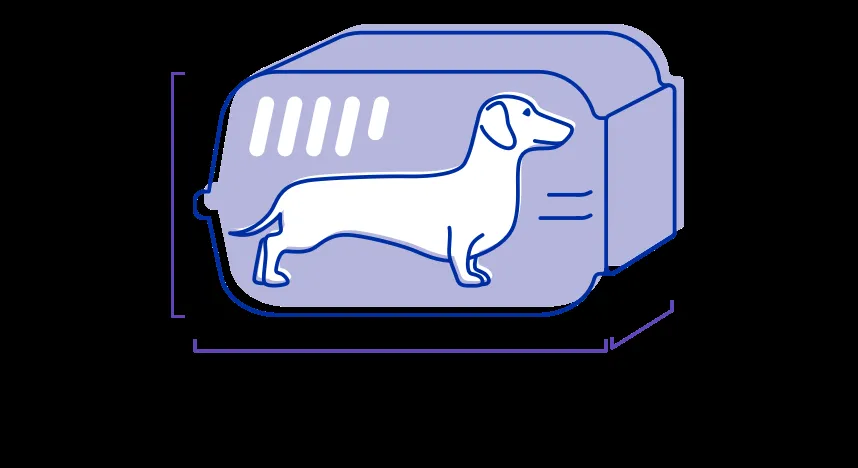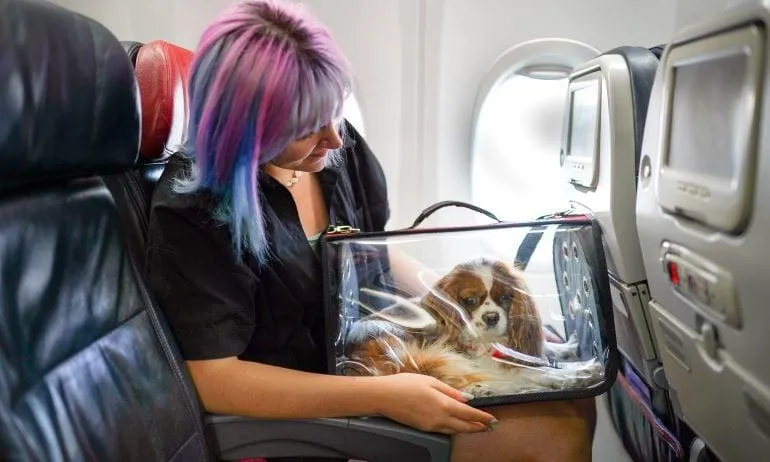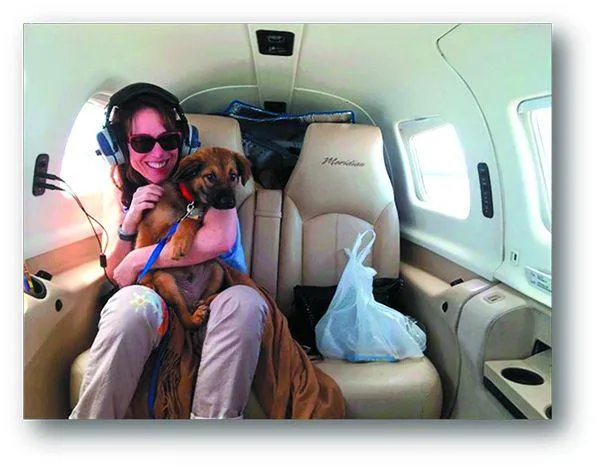Taking Fido Flying: What You Need to Know About Transporting Your Dog on a Plane
If you’re dreaming of taking your furry companion along on your next vacation but aren’t sure about the logistics of transporting your dog on a plane, you’ve come to the right place. In this comprehensive guide, I’ll cover everything you need to know about buying your pooch their own seat, what paperwork is required, size and breed restrictions, and tips for making the journey as stress-free as possible for man’s best friend.
Can I Purchase a Seat for My Dog?
The short answer is yes, most major airlines allow you to purchase an extra seat for your dog to travel in the aircraft cabin. However, there are some key things to be aware of:
- Your dog must be small enough to fit comfortably in a carrier that can fit under the seat in front of you. Typically this means the carrier cannot exceed 16 inches high by 13 inches wide by 8 inches deep.
- You’ll need to purchase an extra “Pet Carry-On” ticket, similar to how you would buy a seat for a child. Prices vary by airline but expect to pay $100-200 each way depending on route.
- Only one pet carrier is allowed per passenger. So if you have multiple dogs, you’ll need to purchase separate tickets for each.
- There may be breed restrictions so be sure to check the airline’s policy on restricted dogs like pit bulls before booking.
From my experience traveling with pets, it’s always worth paying the fee for an extra seat. Your dog will have their own space to feel secure in rather than being stowed with luggage. Just be prepared for some extra paperwork!
What Documentation Do I Need?
In addition to your dog’s ticket, you’ll need to provide several important documents to the airline at check-in:
- Proof of current vaccinations signed by your vet, including rabies, DHLPP, and Bordetella vaccines.
- A health certificate from your vet stating your dog is free of contagious diseases and fit to fly. This certificate cannot be more than 10 days old.
- If traveling internationally, you may need an import/export permit and proof of microchipping depending on the destination country’s requirements.
It’s super important not to forget any of these forms or you risk your dog being denied boarding. Keep copies accessible on your phone too in case of issues along the way. While tedious, the paperwork proves your pup is safe to travel with other passengers.
What Size Carrier Should I Use?
Since your dog will need to fit under the seat, their carrier plays a key role in whether they can join you in the cabin. Like I mentioned before, most airlines mandate a maximum size of 16 inches high by 13 inches wide by 8 inches deep for the Best Friends Flying program.

But even within those dimensions, you’ll want to purchase a carrier that provides your pooch plenty of comfortable room to stand up, turn around, and lie down in their natural posture. Basically, err on the smaller side versus cramming Fido into the largest allowed space.
Soft-sided carriers tend to be cozier than hard plastic kennels, help relieve anxiety, and are usually lighter for carrying onboard. Just be sure it’s FAA-approved for airline travel. Proper sizing and a secure carrier will make all the difference in a smooth flight for your furry friend.
What About Breed Restrictions?
Certain dog breeds have tougher restrictions or outright bans on flying in-cabin due to perceived aggression or size concerns. Here are the policies of major US airlines:
- American, Delta, United – Prohibit pit bull type dogs like American Staffordshire Terriers.
- Alaska – Allows pit bulls with photo ID and vet health certificate but no emotional support letter.
- Southwest – No breed restrictions but dogs must fit in carrier beneath seat (max size 17″ x 12″ x 9″).
- JetBlue – Generally allows all breeds with paperwork but may deny bully or mastiff types.
So if your pup is a restricted breed, inquire very early about any exceptions or check with air cargo instead of cabin transport. Photography and positive behavior history can help in some cases of perceived aggression prejudices.
How Can I Keep My Dog Calm During the Flight?
Even the chillest of canines can feel unsettled flying. Here are some tips to help minimize stress:
- Consider anxiety medication prescribed by your vet. Ask them what’s safe based on your dog’s size and health profile.
- Bring comfortable blankets or toys that smell familiar from home for comforting scents.
- Practice “carrier training” ahead of time so your dog associates it with positive rewards, not punishment.
- Ask for arabian treats and water when allowed during boarding instead of only at destination.
- Request a quiet bulkhead row or bassinet so barking behind doesn’t startle your pup.
- Play calming pheromone diffusers or calming music apps on your phone near the carrier.
With preparation and patience, even nervous fliers can adjust to plane travel over time. Have compassion for your pet and be their advocate with crew for smooth sailings together!

What If My Dog Is Emotional Support or Service Animal?
While “support” and “therapy” dogs do not have the extensive legal protections of trained service animals under the ADA, many airlines do offer more lenient policies for flying with them. For instance:
- You just need a note from your mental health provider stating your need vs full vaccination records.
- They fly in-cabin with you for free instead of buying a pet ticket.
- Larger or restricted breeds may get exceptions with proper documentation.
- They aren’t required to be leashed or crated but must behave well on flights.
However, these accommodations attract pretenders too. Only claim emotional support status if your dog actively mitigates a diagnosed condition versus merely providing comfort. Respectfully follow all airline policies to avoid abusing this privilege for others who genuinely depend on it.
Tips for the Big Day of Departure
With paperwork in order, carrier prepared, and a calm canine companion, you’re almost ready to take off! Here’s what to remember on travel day:
- Arrive at least 2 hours early for check-in to allow extra time with a pet in tow.
- Bring pee pads, poop bags, and any necessary supplies in your carry-on in case of delays.
- Request a physical inspection of carrier from airline staff before check-in if they offer it.
- Pack kibble or snacks in carry-on to serve as in-flight treats if meals are provided.
- Consider pre-treating with calming aids 30-60 minutes before boarding to take full effect.
- Display identification tags and address clearly on carrier in case it’s misplaced en route.
With advance planning and following the rules, there’s no reason your faithful furry companion can’t join you in the skies. Safe travels to you both, and bon voyage!
Let me know if you have any other pet travel questions. From all my years rescuing and flying with dogs, I’d be happy to help demystify the process. Happy trails to you and your best friend wherever the road may lead!
Factors to Consider When Choosing a Plane Seat for Your Dog
| Carrier | Size Requirements | Fee |
|---|---|---|
| Delta | Under 20 lbs, must fit under seat | $125 each way |
| United | Under 20 lbs, must fit on owner’s lap | $125 each way |
| American | Under 20 lbs, must fit on owner’s lap | $125 each way |
| Alaska | Under 20 lbs, must fit on owner’s lap | $125 each way |
| JetBlue | Under 20 lbs, must fit on owner’s lap | $100 each way |
FAQ
-
Can I buy a plane seat for my dog?
Basically yes, some airlines allow you to purchase an extra seat for your pet to travel in the cabin. However, there are usually size and weight limits so really big doggos might have to ride in the cargo hold. You’ll need to contact the airline directly to check their specific pet policies.

-
Do I need a special kennel or carrier for my dog?
Pretty much all airlines that allow pets in the cabin say the pooch has to ride in an FAA-approved hard-sided kennel or carrier. The kennel needs to be big enough for them to stand up and turn around in, but not too massive that it won’t fit under the seat. Might be kinda tricky to find the right size kennel – do your research!
-
What documents do I need for my dog’s plane trip?
To fly with a canine companion, you’ll generally need some paperwork like proof of current vaccines, a health certificate from the vet, and an import permit if traveling internationally. Better safe than sorry – get all the paperwork sorted out ahead of time to avoid any issues at the airport. The airline employees have gotta follow the rules, so be fully prepared with docs.
-
Is it stressful for dogs to fly?
Flying on a plane can absolutely be stressful and disorienting for poor pups unused to air travel. They have to sit quietly in a strange hard container for hours – I’d be freaked out too! Luckily, there are things you can do to help minimize stress like training your dog to feel calm and comfortable in their carrier before the big day. Ask your vet about sedation too if really necessary. With some preparation, it may not be quite so awful for anxious animals.
-
How much does an extra plane seat for a dog typically cost?
Ticket prices for canine cabin companions vary widely depending on the airline. Sometimes you can get one for a mere $100-200, but at other carriers extra seats for pets may set you back $250 or even closer to $300. Since dog planes seats aren’t always available, it’s wise to book early if hoping to travel economically with your furry friend. You get what you pay for – is Fido worth the investment?
-
Can two people share one extra seat for one dog?
This may depend on the size of the pooch and specific policies of the airline. Generally most will only allow one human and one animal per extra ticketed seat for safety and to not disrupt other passengers. However, if lil’ Toto is tiny enough perhaps two people could squeeze in together – although the flight attendants may not appreciate that. It’s best to check rules carefully to avoid any trouble at the airport.
-
Do airlines ever offer sales or discounts on pet tickets?
Once in a blue moon, a carrier may have a sale where pet fares are somewhat reduced. Keep an eye out for promotions around holidays or “bring your pet to work day” sorts of occasions. If the flight isn’t too full, there’s also an outside shot at occasionally getting an compassionate upgrade. But realistically airline prices for animals aren’t hugely flexible – you gotta pay to play, or else kennel Fido below.

